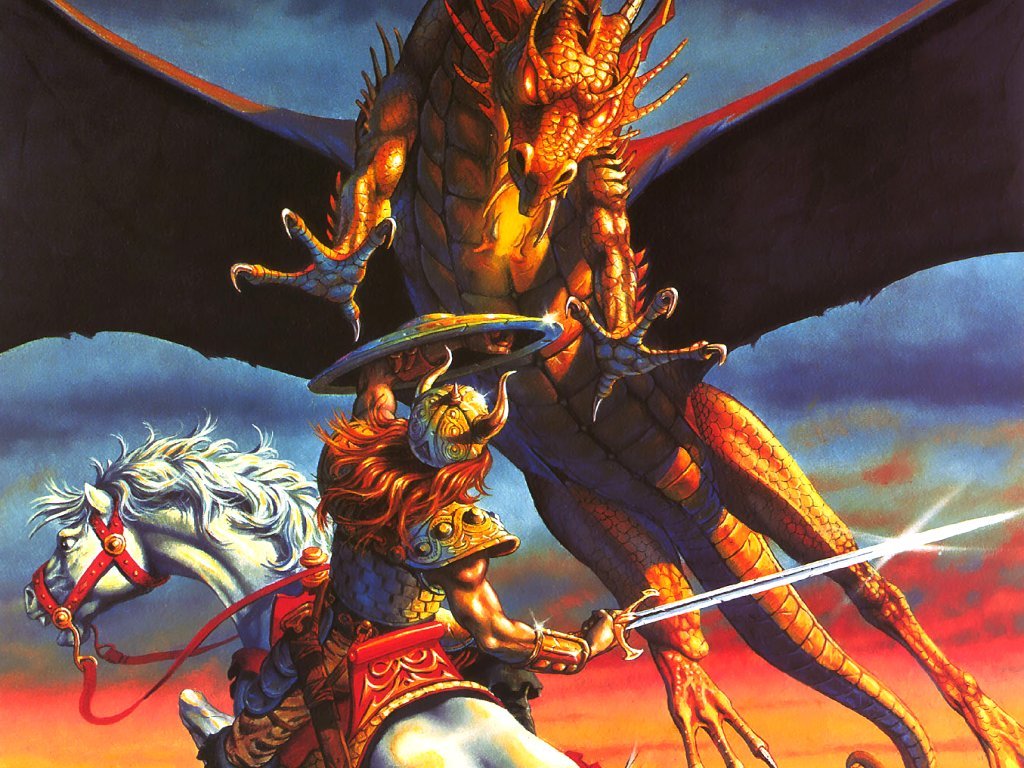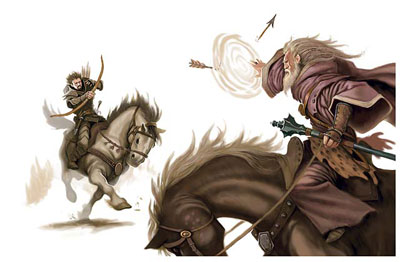

|
|
|
|
|
|
|
|
|
|
|
|
| Rules
for Mounted Combat
Although the sweeping
charges of vast ranks of cavalry are not
In order for a steed to function as a mount
during combat, it
Steeds that may be employed by the races
of the Underdark
A mounted character wielding a melee weapon
has certain
|
Melee Combat from a Mount
A character astride a land-based mount
who is engaged in melee
A character who is on foot and fighting
a mounted opponent
A character on a flying mount can engage
in melee combat
A character on the ground may choose to
defend against an attack
A character on a flying mount must be able
to hover in close
<
|
| Missile
Fire from Horseback
The mounted bowman is an integral part
of the armies and fighting styles of the Oriental lands. Vast
Such practice is not for show-it is a vital
and effective form of combat.
There are two ways a character can fire
a bow while on horseback with the horse standing still and with
Table 67: Horseback Bowfire Modifiers
These modifiers are cumulative with those
for range, weapon versus armor type, etc.
|
Mounted Missile
Fire
Mounted bowmen can create a formidable force, combining SPEED with the ability to attack from a distance. Often, a mounted archer can ride close to his enemy, shoot an arrow, and ride away again before the enemy can react. Any character can fire a bow from a mount
that is not moving, without negative modifiers. In order to shoot from
a moving steed, however, the character must have both horsemanship
proficiency and a bow weapon proficiency. This is required because
Shortbows, composite shortbows, and light
crossbows can all
Table 14: MOUNTED BOW FIRE
These modifiers are cumulative with all others that apply. During the round he fires, the rider cannot
perform maneuvers
These rules apply to riders on all types
of mounts. If the steed is flying, additional penalties apply as listed
in the DMG, page 53,
|
Missile
Combat from a Mount

1. Only a character with proficiency in
riding his mount can successfully
2. Even if the weapon does not actually
require two hands to be used, the character must be able to ride
3. Any missile weapon except a longbow or a heavy crossbow can be used from the back of a moving mount. 4. However, the attacker must take a one-step
reduction in his normal rate of fire on the following scale:
5. In addition, a character using a missile
weapoin from the back
MOUNTED BOW FIRE
These penalties are in +addition+ to all
others (range, visibility, etc.) that may apply.
6. During the round he fires, the rider cannot perform maneuvers with his mount, except for slight turning. <(DSG)> 7. It is not possible to USE a missile
weapon with success if the
which firing is attempted. At the Dungeon
Master’s discretion,
As already noted in the DMG <>
on page 53, further penalties apply on any attempt to engage in missile
combat from the back of a flying mount: short range is considered as medium
range and medium range is considered long range for purposes of "to hit"
modifiers unless the mount is hovering. In this case,
SUMMARY MISSILE COMBAT FROM A MOUNT (WGS.86)
* In addition, a character using a missile
weapon from the back of a moving mount suffers a penalty "to hit" based
on the SPEED of the mount:
* It is not possible to USE a missile weapon with success if the mount is performing complex maneuvers, or if the mount is turned at an angle of more than 45 degrees during the round in which firing is attempted. * As already noted in the DMG <> on page 53, further penalties apply on any attempt to engage in missile combat from the back of a flying mount; short range is considered as medium range and medium range is considered long range for purposes of "to hit" modifiers unless the mount is hovering. |
| Unhorsing
In a world where the horseman is an important
and formidable warrior, defending against him and
Oriental warriors prefer to bring the rider
down without harming the horse. Hits from weapons can
Foot soldiers using melee weapons of 5
to 9 feet in length have the same chance as a mounted attacker
Riders can also be pulled from the saddle
by both mounted and unmounted men. A mounted man can
Man on foot can also attempt to pull a
rider from his horse, although this is not an easy task. The attempt
modifier is -4, and at speeds greater than
12' the modifier is -6. If the hit is successful, the rider must make a
For each additional footman grappling (up
to 4), -1 is applied to the proficiency check. If the rider is
Finally, given time and materials, set
defenses can be prepared to dismount riders and stop horses. Most
Stakes:
For defense against horse attack, sharpened stakes can be set in
The rules for dismounting a horse rider
also apply to other riding creatures that a character may
|
Forcing Opponents
to Dismount
Although the mounted warrior gains a few advantages over his opponents on the ground, special tactics have evolved to allow those opponents to even the odds somewhat. The most straightforward approach is to try to knock the rider off his mount. This more than evens the odds, since the rider is generally stunned, injured, or at the very least, prone after falling from his mount. There are several methods for dismounting
an opponent, some of which are heroic and others that are merely grim and
efficient.
If a steed is killed while a character
is mounted upon it, the character automatically falls to the ground. If
the character has horsemanship proficiency (see
the proficiency rules on page 23), <>
Often, combatants attempt to bring a rider
down without killing the steed. Some weapons are more effective than others
at accomplishing this. Anytime a rider is struck by a melee weapon of three
feet or greater length wielded by another mounted character, and the attack
roll is a natural 20, there is a chance that the victim is knocked from
his mount. If the rider does not have horsemanship proficiency, he is automatically
knocked to the ground, and suffers an additional 1d3 points of damage.
If the character
Fighters on foot who are armed with weapons
of five to nine feet in length have the same chance of unhorsing riders
as mounted attackers do-and riders have the same chance of remaining in
the saddle in both instances. Foot soldiers using weapons of 10 feet or
greater lengths have a 25% chance of dismounting riders (a roll of 16-20
on the attack roll) . Again, riders with horsemanship proficiency are allowed
to check to see if they
Riders can also be pulled from their mounts
by both mounted and unmounted attackers. A mounted attacker can attempt
to dive on another rider by moving adjacent to him and leaping from
If the rider remains mounted with his attacker
clinging to him, the procedure is repeated in subsequent rounds. In order
to keep his place, the attacker must successfully roll to hit; if he does
so, the rider must make another Proficiency Check to remain in the
Characters and creatures on foot can also attempt to pull a rider from his horse, although this is not an easy task. The attempt can only be made by creatures that are man-sized or larger. Those larger than man-size count as two men for the attempt. First, the character on foot must grab
the rider as he passes by. To do this, he makes an attack roll, modified
by the speed of the mount. If the steed is moving at 6” per round or less,
the attacker’s
For each additional footman grappling (up
to 4), -1 is applied to the rider’s Proficiency Check. If the rider is
pulled from his mount by more than one person, he suffers no damage, since
his opponents
Finally, given time and material, set defenses
can be prepared to dismount riders and stop horses. Most of these are simple
tricks and traps, such as a rope hung between two columns at the rider’s
height, a trip wire, etc. The DM determines the chance of
Stakes: For defense against mounted
attackers, sharpened stakes can be set in the ground. It takes two characters
one hour to prepare a 10-foot-square area with stakes of about four to
five feet in length, provided that there is a supply of saplings, light
wood, or spears to use as stakes. These defensive
If a rider wishes his mount to enter such an area, the player must make a horsemanship Proficiency Check, just as if he were trying a jump or leap. Failure means that the mount refuses to enter the AREA, although it continues moving in another direction if possible. If the check succeeds, the mount enters the defended area and hits 0-3 (ld4-1) stakes for each 10-foot-depth of the defenses. Barding reduces the number of stakes that hit by -1 for chain mail barding, and -2 for plate barding. Each stake causes 2d6 points of damage to the mount, whether or not the steed was charging at the time. <>
8. At the DM's discretion,
<>
<numbers added. This version integrates
the rules from OA & DSG>
Q: Can any mounted
character fire a bow weapon while riding a horse (or other mount)?
A: They're both correct.
|
Forcing Opponents to Dismount A mounted character should always anticipate
the possibility
If a land-based mount is killed while a
character is riding it, the
If a flying mount takes damage that brings
it to less than half of
If a flying mount is killed while a character
is aboard, the creature
A mounted character using a melee weapon
of at least 3 feet in
A character standing on the ground can
unseat a mounted opponent
Finally, a character (mounted or on foot)
can attempt to unseat
If an attacker remains clinging to a mounted
opponent, the attacker
|
<
Lances: A lance is a long
spear carried by a mounted man.
Norman
lances were about 12' in length,
but later in the Middle Ages the weapon
grew to an average length of about 14' --
thus effectively giving the horseman about
10' of reach beyond the horses's head when charging.
- Unearthed Arcana, page 124
>